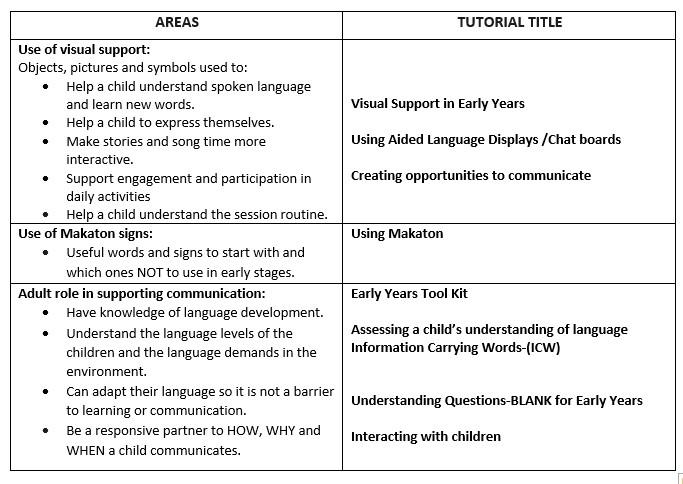Online Workshops for Nurseries and Parents
Communication workshops and demonstrations available online
Online training tutorials have been devised and are now available for staff at Knowsley settings. Accessing training this way is beneficial because:
- It can be accessed on a mobile device/laptop etc at any time by staff members.
- Staff cover to enable a staff member to attend a location is not required.
- Accessing online training reduces cost and disruption for a setting.
- The information can be replayed and repeated to support adult learning.
- That “see what to do” approach is an effective teaching tool to support implementation of best practice methods. It will support consistency and sustainability of best practice in a nursery.
- Visual demonstrations of activities and how to carry out strategies can be watched repeatedly.
- Feedback can be collated and used as a measure of effectiveness and usefulness
I investigated the Communication Trust research on supporting the Code of Practice and ensuring a child’s participation in the process. I referred to their Toolkit for Education settings: Involving children and young people with SLCN and how to support Communication Friendly Early Years Environments. I also referenced the 10 action points from The Research Centre for Experiential Education (RCEE) that should help practitioners to focus the learning environment on the well-being and involvement of pupils.
Using both of these researches, evidence-based approaches, a set of training has been devised to link in with key areas required for settings to implement in order to promote best practice.

You can view the above as a word document if necessary - Speech and Language table
CONTENT OF WORKSHOPS
EARLY YEARS COMMUNICATION TOOL KIT
OUTLINE
- To recognise risk factors for children developing communication difficulties birth -3 years.
- To have information regarding ages and stages in communication development.
- To feel confident about how and when to request support from a Speech and Language Therapist.
- To be aware of ways to promote early language development.
- To be aware of Total Communication strategies.
- Support for children with English as an Additional Language ( )
ADULT-CHILD INTERACTION STYLES
OUTLINE- Understand how different adult interaction styles impact on a child’s communication style and opportunities to communicate.
- Understand how to adapt adult interaction styles to promote a child’s communication opportunities.
- Understand how and why to adapt environments to promote a child's communication motivation.
UNDERSTANDING QUESTIONS-BLANK LEVELS
OUTLINE
- Look at the different levels of questions and instructions in the Blank Model of Language Learning.
- Understand the difference between concrete and abstract language.
- Consider how to step up and step-down questions and instructions for children at different levels of understanding.
- Understand the importance of using comments more than questions as a strategy to support language learning.
- Look at practical resources to help children develop more abstract language skills.
- Using the Blank Model to support choosing an appropriate behaviour management strategy.
INFORMATION CARRYING WORDS
OUTLINE
- Understand the concept of Information Carrying Words (ICW).
- How to introduce and work at different word levels.
- How to use ICW activities to develop receptive and expressive language.
USING MAKATON SIGNS
OUTLINE
- Understand the need for the use of signs as a means of communication for children with SLCN.
- Understand how the use of signs can help a child understand spoken language.
- Learn signs for some core functional words.
- Learn about resources available to help staff and parents learn signs in their home or nursery environments.
CREATING OPPORTUNTIES TO COMMUNICATE (MEANS, REASONS AND OPPORTUNITIES MODEL)
OUTLINE
Understand how to:
- support a child’s means of communication
- provide an environment that supports a child’s reasons to communicate
- provide opportunities to do so at school and at home.
- Learn how to implement the information above in a Nursery /home environment.
VISUAL SUPPORT IN EARLY YEARS
OUTLINE
- Understand the need for the use of different types of visual support to help a child's under- standing and expressive language.
- Different types of visual support.
- Where to access resources.
USING AIDED LANGUAGE DISPLAYS/CHATBOARDS
OUTLINE
- Understand the term Alternative Augmentative Communication (AAC).
- Understand the difference between no/low/high tech systems.
- Understand how to support the use of Aided Language Display (ALD)/Topic Chat Boards through modelling language and commenting.
- Understand the difference between Core and Fringe vocabulary
- Where to access resources and information
So how do you find these?
You can visit the Resources for Knowsley by opening our website www.chattytherapy.co.uk
You will then have access to the above catalogue of training tutorials. There are also handouts for each workshop available in PDF version for you to print and add notes to.
There are some demonstrations to show how to carry out the following:
- Assess a child’s understanding and use of language
- Sabotage strategies to promote a reason to communicate
- How to use chat boards
- Some ideas for games and activities to support early foundation skills for joint engagement; choice making; words to use; turn taking.
You can also visit our Workshop/Demonstrations section
****Please complete an evaluation sheet once you have watched a tutorial. Your feedback will be essential for me to know what to adapt and to improve on this training*****************
Jo Clarke
Speech and Language Therapist
E: jo.clarkeslt@gmail.com
T: 07599202530

October 2020

